SURFACE AREAS AND VOLUMES for Class 9 MATHS
INTRODUCTION
Hello Bachcho, aap apne aas paas normally jo bhi dekhte ho wo solid form ki hoti hai. Hum apni studies mai unn sabhi figures se deal karte hai jo easily hum apni notebook ya blackboard par draw kar sakte hain. Inn sab ko plane figures kehte hai. Hum already samajh chuke hai ki square, rectangle, circle kya hota hai aur inke perimeters, area kaise nikalte hai. Yeh sab hum apni phechli classes mai padh chuke hain. Aur bachcho ye dekhna bahot hi zyada interesting hoga ki if we cut out many of these plane figures of the same shape and size from cardboard sheet and stack them up in a vertical pile. Iss process se aapko kuch new figures dekhne ko milenge jaise ki cube, cuboid, cylinder, etc. Aapne earlier classes mai inke bare mai thoda bahot padha hua hai. Toh ab iss chapter mein hum different figures ka surface area and volume detail mai nikalna sikhenge with very interesting and different examples.

Explanation
Toh bachcho iss chapter mai hum surface area and volume of different solid shapes such as the cube, cuboid, cone, cylinder, and so on. Surface area ko generally lateral surface area (LSA), curved surface area (CSA) and total surface area (TSA) mai divide kiya gaya hai. Abh aage hum different three dimensional shapes ke surface area ke formulas and volumes ke formulas ko detail mai padhenge. Iss chapter mai hum two shapes ke combination ko bhi padhenge. It would be very interesting to study all these combination.
Surface Areas and Volumes
The surface area of any given object is the area or region occupied by the surface of the object. Whereas volume is the amount of space available in an object. In geometry, there are different shapes and sizes such as sphere, cube, cuboid, cone, cylinder, etc.
Surface Area of a Cuboid and a Cube
Toh bachcho ek example ke through hum surface area of cuboid ko samjhenge.
Kya aapne bahot sari sheets ka bundle dekha hai? kaisa dikhta hai?
Agar aapko nahi pata toh aap iss image mai dekh sakte hai.
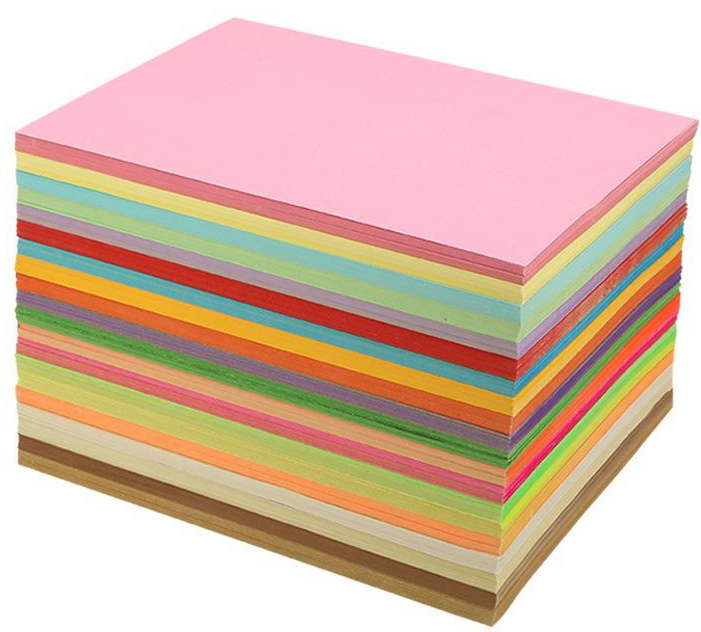
Toh jaisa ki aap dekh sakte hai ki yeh ek cuboid ki tarah dikh raha hai. Toh abh hume yeh dekhna hai ki agar hum iss bundle ko cover karna chahte hai to kitne paper ki zarurat padegi? Toh chalo dekhte hai :-
(a) Sabse pehle hume ek rectangular sheet lenge bottom ke liye taki sari sheets uske upar rakhi jaye.

(b) Abh hum two long rectangular sheets lenge taki hum uss sheet ke dono side mai laga sake.

(c) Abh hume front aur back ends ko cover karne ke liye, we would need two more rectangular pieces of a different size.

(d) Abh tak humne jo bhi banaya hai abh hum usko ek baar open karke dekhenge. Toh wo kuch (below image) aisa dikhega.

(e) Abh hume iske top ko cover karne ke liye bhi same size ka rectangular piece chahiye jo humne bottom mai liya tha, aur agar hum usko right side mai lgayenge to wo kuch (below image) aisa dikhega.
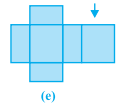
(f) So we have used six rectangular pieces to cover the complete outer surface of the cuboid.
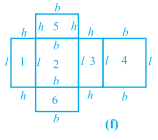
A cuboid is a box-like shape. It has six rectangular faces. The faces opposite each other are equal.
This shows us that the outer surface of a cuboid is made up of six rectangles (in fact, rectangular regions, called the faces of the cuboid), whose areas can be found by multiplying length by breadth for each of them separately and then adding the six areas together.
Now, if we take the length of the cuboid as l, breadth as b and the height as h.
So, the sum of the areas of the six rectangles is:
Area of rectangle 1(=l×h)
+
Area of rectangle 2(=l×b)
+
Area of rectangle 3(=l×h)
+
Area of rectangle 4(=l×b)
+
Area of rectangle 5(=b×h)
+
Area of rectangle 6(=b×h)
+
=2(l×b)+2(b×h)+2(l×h)
=2(lb+bh+hl)
This gives,

where l,b and h are respectively the three edges of the cuboid.
Toh bachcho aapne abh tak upar sirf cuboid ke barein mai padha hai abh hum cube ke barein mai padhenge.
Recall that a cuboid, whose length, breadth and height are all equal, is called a cube. If each edge of the cube is a, then the surface area of this cube would be
2(a×a+a×a+a×a), i.e., 6a

where a is the edge of the cube.
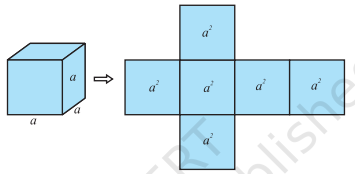 Abh aap suppose kare ki cuboid ke six faces mai se hum only four faces (leaving top and bottom) ka hi area find karenge. So, the area of these four faces is called the lateral surface area of the cuboid.
Abh aap suppose kare ki cuboid ke six faces mai se hum only four faces (leaving top and bottom) ka hi area find karenge. So, the area of these four faces is called the lateral surface area of the cuboid.
So, lateral surface area of a cuboid of length l, breadth b and height h is equal to 2lh+2bhor2(l+b)h.
Similarly, lateral surface area of a cube of side a is equal to 4a2.
Remember
The surface area of a cuboid (or a cube) is sometimes also referred to as the total surface area.
Properties of Cuboid
- A cuboid has 6 faces, 8 vertices, and 12 edges.
- All the angles formed at the vertices of a cuboid are right angles.
- All the faces of a cuboid are rectangular in shape.
- Two diagonals can be drawn on each face of a cuboid.
- The opposite edges of a cuboid are parallel to each other.
- The dimensions of a cuboid are length, width, and height.
Properties of Cube
- A cube has 12 edges, 6 faces, and 8 vertices.
- All the faces of a cube are shaped as a square hence the length, breadth, and height are the same.
- The angles between any two faces or surfaces are 90∘.
- The opposite planes or faces in a cube are parallel to each other.
- The opposite edges in a cube are parallel to each other.
Example 1
Three cubes each of side 5cm are joined end to end. Find the surface area of the resulting cuboid.
If we join these three cubes, then the length of the resulting cuboid will be 5+5+5=15cm.
Breadth and height will be 5cm.
∴ Surface area of the cuboid will be,
S=2(lb+bh+hl)=2(15⋅5+5⋅5+5⋅15)=2(175)=350cm2.
Example 2
The sum of length, breadth and depth of a cuboid is 19cm and the length of its deagonal is 11cm.
Find the surface area of the cuboid.
Let length be l
Let breath be b
Let height be h
l+b+h=19
Length of diagonal=√l2+b2+h2
11=√l2+b2+h2
112=l2+b2+h2
112=192−2(lb+lh+hl)
surface area of cuboid=192−112
=240cm2.
Surface Area of a Right Circular Cylinder
Agar hum bahot sari circular sheets ko ek dusre ke upar stack kare jaise ki humne rectangular sheets ko kiya tha toh wo kuch (below image) aisa dikhega.

Agar hum continuously sheets ko vertically stack karte hai toh, we get what is called a right circular cylinder. Because it has been kept at right angles to the base, and the base is circular.
Toh bachcho abhi aapne padha ki right circular cylinder kaisa hota hai but abh aap dekhoge ki kis tarah ke cylinder right circular cylinder nahi hote.
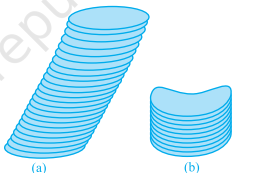
Aap figure (a) ko dekho wo aapko ek cylinder ki shape mai dikhega lekin wo right circular cylinder nahi hai because it is not at right angles to the base.
Figure (b) mai uska base hi circular nahi hai toh wo automatically right circular cylinder nahi hai.
Toh chalo uss paper sheets ke bundle ke cylinder ko cover karte hain. How will we do it with the minimum amount of paper?
Toh sabse pehle aap ek rectangular sheet le lijiye, whose length is
just enough to go round the cylinder and whose breadth is equal to the height of the
cylinder.

The area of the sheet gives us the curved surface area of the cylinder. Note that the length of the sheet is equal to the circumference of the circular base which is equal to 2πr.
So, curved surface area of the cylinder
= area of the rectangular sheet = length × breadth
= perimeter of the base of the cylinder × h
= 2πr×h.
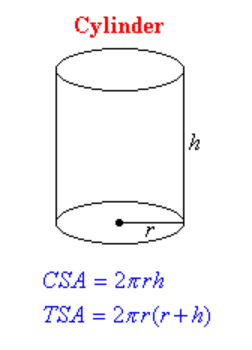
where r is the radius of the base of the cylinder and h is the height of the cylinder.
Agar hum cylinder ka top aur bottom dono cover karna chahte hai toh hume two circles chahiye, each of radius r, and area is πr2, giving us the total surface area as 2πrh+2πr2=2πr(r+h).
π=227or3.14

where h is the height of the cylinder and r its radius.
Properties of Right Circular Cylinder
- It has two curved edges, one curved surface, and two flat faces.
- Cylindrical bases always are congruent to each other.
- The base and the top of the cylinder always are identical to each other.
Example 3
The inner diameter of a circular well is 3.5m. It is 10m deep.
Find (i) Its inner curved surface area,
(ii) The cost of plastering this curved surface at the rate of Rs40 per m2.
1) CSA=2πrh
=2×227×(3.52)2×10
=110m2
2)1m2=40Rs
110m2=110×40Rs
=4400Rs
Example 4
In a hot water heating system, there is a cylindrical pipe of length 28m and diameter 5cm. Find the total radiating surface in the system.
Radiating Surface=CSA of given cylinder
=2πrh
=2⋅22h⋅0.05⋅28
=4.4m2.
Surface Area of a Right Circular Cone
A right circular cone is one whose axis is perpendicular to the plane of the base. We can generate a right cone by revolving a right triangle about one of its legs.

Iss figure mai aap ek right circular cone dekh sakte ho aur ek circular base jiska radius r hai aur iski axis base ke perpendicular hain. Jo line vertex ko base ke center se connect karti hai wo height of the cone kehlati hai. The length at the outer edge of the cone, which connects a vertex to the end of the circular base is the slant height.
For a right circular cone of radius ‘r’, height ‘h’ and slant height ‘l’, we have;

Formula of slant height is
l=√r2+h2
Agar hume cone ke base yani circular portion ka bhi area nikalana ho to hume iske curved surface area mai circle ke area ko bhi add karna padega.
=πr2+πrl
=πr(r+l)

Properties of Right Circular Cone
- It has a circular base. The axis is a line that joins the vertex to the center of the base.
- The slant height of the cone is measured from the vertex to the edge of the circular base. It is denoted by l or s.
- The altitude or height of a right cone coincides with the axis of the cone and is represented by h.
- If a right triangle is rotated with the perpendicular side as the axis of rotation, a right circular cone is constructed. The surface area generated by the hypotenuse of the triangle is the curved surface or the lateral surface area.
Example 5
Find the curved surface area of a right circular cone whose slant height is 10cm and base radius is 7cm.
CSA=πrl
=227×7×10
=220cm2.
Example 6
A joker’s cap is in the form of a right circular cone of base radius 7cm and height 24cm.
Find the area of the sheet required to make 10 such caps.
Curved surface Area of cone=π×r×l
where randl are the radius and slant height of the cone
slant height=l=√r2+h2
given r=7cm and h=24cm thus slant height =25cm.
Curved surface Area of cone==π×7×25=550(cm)2
Surface Area of a Sphere
Bachcho aapke mind mai sphere aur circle ko lekar kafi sare questions aate honge.
Jaise ki sphere kya hai? Kya circle aur sphere same hai?
Kya aap circle ko ek paper par draw kar sakte hai? The answer is yes. Because circle ek plane closed figure hai jiske sare points ek constant distance (center) se form hote hai. Agar aap ek string ko circular arc ke diameter ke sath tie karke usko rotate karte hai to aap ek solid dekhoge.
Now the question is kya yeh solid ek sphere hai? So, the answer is yes.

Can you guess circle ke center ka kya hota hai jab wo sphere ban jata hai. Of course, it becomes the centre of the sphere. Sphere ek three dimensional figure hai, which is made up of all points in the space, which lie at a constant distance called the radius, from a fixed point called the centre of the sphere.
Sphere ke outer surface ko surface area of sphere kehte hai.

Circle aur sphere mai main difference yeh hai ki circle 2 dimensional hota hai aur sphere 3 dimensional hota hai. Yeh formula Archimedes ne diya tha. Now we will see the relation between cylinder and sphere.
Agar cylinder aur sphere ka radius r hai to sphere ka surface area aur cylinder ka lateral surface area equal hoga.
Surface Area of Sphere = Lateral Surface Area of Cylinder
⇒ The surface area of Sphere = 2πrh
Height of cylinder = Diameter of sphere = 2r
Surface area of sphere is 2πrh=2πr(2r)=4πr2 square units.

How many faces do you see in the surface of a sphere?
There is only one, which is curved.
Abh hum ek sphere lenge aur ushe ekdum centre se plane ke through cut kar lenge.

Yes, it gets divided into two equal parts.
What will each half be called?
It is called a hemisphere.
Hemisphere ke two faces hai ek curved face and dusra flat face (base). The curved surface area of a hemisphere is half the surface area of the sphere, which is 12of4πr2.

Where r is the radius of the sphere of which the hemisphere is a part.
Now taking the two faces of a hemisphere, its surface area
2πr2+πr2

Properties of Sphere
- A sphere is perfectly symmetrical.
- All the points on the surface are equidistant from the centre.
- It does not have a surface of centres.
- It has a constant width and circumference.
Properties of Hemisphere
- A hemisphere has a one curved surface area.
- Just like a sphere, there are no edges and no vertices in a hemisphere.
- The diameter of a hemisphere is a line segment that passes through the center and touches the two opposite points on the surface of the hemisphere.
- It is created when a plane intersects the center of a sphere cutting it into two equal halves.
NOTE
A sphere is like the surface of a ball. The word solid sphere is used for the solid whose surface is a sphere.
Example 7
Find the radius of a sphere whose surface area is 154 cm2
We know surface area of a sphere can be given by,
A=4πr2
So, 4πr2=154
⇒4×227×r2=154
⇒r2=154×722×4=494
⇒r=√494=72=3.5
So, radius of sphere will be 3.5cm.
Example 8
Find the surface area of a sphere of radius: (i) 10.5 cm (ii) 5.6 cm (iii) 14 cm
The surface area of a sphere can be given as S=4πr2
(i) Here, r=10.5cm
So, S=4×227×10.5×10.5
=132×10.5=1386cm2
(ii)Here, r=5.6cm
So, S=4×227×5.6×5.6
=88×0.8×5.6=394.24cm2
(iii)Here, r=14cm
So, S=4×227×14×14
=88×28=2464cm2
Volume of a Cuboid and Cube
The volume of a cuboid can be found by multiplying the base area with the height.
Therefore,
Volume of the cuboid = (length × breadth × height) cubic units.

The volume of the cube is equal to the product of the area of the cube and height. Jaisa ki hum jante hai ki cube ke sare edges ki length same rehti hai.
Hence,
Volume of the cube =l2×h
Since, l=h
Therefore,
Volume of the cube = l2×l
Volume of the cube = l3

Example 9
A cuboidal water tank is 6m long, 5m wide and 4.5m deep. How many litres of water can it hold? (1 m3= 1000l)
Water tank can hold water equal to its volume.
As tank is a cuboid in shape, its volume will be ,V=l×b×h
Here, Length,l=6m
Breadth,b=5m
Height, h=4.5m
So, V=6×5×4.5=135m3
Also, 1m3=1000l
So, V=1,35,000l
So, the water tank can hold 1,35,000 litres of water.
Example 10
Find the volume, the total surface area and the lateral surface area of a cuboid which is 15m long, 12m wide and 4.5m high.
Here, l=15m , b=12m and h=4.5m
Volume of the cuboid =(l×b×h) cubic units
=(15×12×4.5)m3=810m3
Total surface area of the cuboid
=2(lb+bh+lh) sq units
=2(15×12+12×4.5+15×4.5)m2=603m2
Lateral surface area of the cuboid
=[2(l+b)×h] sq units
=[2(15+12)×4.5]m2=243m2
Volume of a Cylinder
Jaisa ki aapne dekha humne rectangular sheets se ek cuboid banaya aur ushi tarah humne circular sheets se cylinder banaya. Toh jaise humne cuboid ke liye argue ki ushi tarah hum cylinder ki volume ko bhi calculate kar sakte hai.
base×height
= area of circular base × height
=πr2h

Example 11
Find the (i) Volume,
(ii) Area of curved surface and
(iii) Total surface area of a cylinder having radius of the base 14cm and height 30cm.
Here, r=14cm and h=30cm
(i) Volume of the cylinder =(πr2h) cubic units
=(227×14×14×30)cm3=18480cm3
(ii) Curved surface area of the cylinder =(2πrh) sq units
=(2×227×14×30)cm2=2640cm2
(iii) Total surface area of the cylinder
=(2πrh+2πr2) sq units =2πr(r+h) sq units
={2×227×14×(14+30)}cm2=3872cm2
Example 12
The total surface area of a cylinder of radius 7cm is 880cm2.
Find the height and the volume of the cylinder.
Given, r=7cm. Let the height of the cylinder be h cm.
Then, total surface area =(2πr2+2πrh) sq units
=2πr(r+h) sq units
=2×227×7×(7+h)cm2
=44(7+h)cm2
∴44(7+h)=880⇒(7+h)=20⇒h=(20−7)=13
Hence, the height of the cylinder is 13cm
Volume of the cylinder =(πr2h) cubic units
=(227×7×7×13)cm3=2002cm3
Hence, the volume of the cylinder is 2002cm3
Volume of a Right Circular Cone
Ek right circular cone ne jitna space occupie kiya hai wo uska volume kehlata hai. The volume of the right circular cone is equal to one-third of the product of the area of the circular base and its height. Jaisa ki hum jante hai ki right circular cone three dimensional hai to uski volume bhi three dimensional hogi. The volume of the cone is equal to one-third of the product of the area of the base and its height. The base area of the cone is obtained by multiplying the square of its radius to π.
Volume of cone =13πr2h
r= radius of the base circle
h= height of the cone.
=πr2h

Example 13
The height and the slant height of a cone are 21cm and 28cm respectively.
Find the volume of the cone.
Volume of cone =13πr2h
slant height=L=√r2+h2
substituting values we get = r=√343cm
volume of cone=13×227×343×21=7546(cm)3
Example 14
A right triangle ABC with sides 5cm,12cm and 13cm is revolved about the side 12cm.
Find the volume of the solid so obtained.
When we revolve a right angle triangle, we get a conical shape.
Please refer to video for the figure of cone.
So, here, height of cone, h=12cm
Radius of cone, r=5cm
Volume of cone, V=13πr2h
V=13×227×5×5×12=22007=314.21cm3
So, volume of obtained solid will be 314.21cm3.
Volume of a Sphere and Hemisphere
The volume of sphere is the capacity it has. Sphere ek three dimensional shape hai. Iske three axes hai x - axis, y- axis and z - axis, which defines its shape. Football, Basketball sphere ke example hai.
Sphere ki volume uske diameter par depend karti hai. Jab hum ek circle ko rotate karte hai to sphere ki formation hoti hai. Archimedes’ principle helps us find the volume of a spherical object. It states that when a solid object is engaged in a container filled with water, the volume of the solid object can be obtained. Because the volume of water that flows from the container is equal to the volume of the spherical object. Volume ko cubic units mai measure karte hai (∈3,ft3,cm3,m3, etc ). Make sure ki aapke sare measurements same units ke ho volume nikalne se pehle.
The volume V of a sphere is four-thirds times pi times the radius cubed.
Volume of Sphere = 43πr3

Higher classes mai aap ishe prove karna bhi sikhoge, but is stage par we will just take it as true. Jaisa ki aap sab jante hai ki hemisphere sphere ka half part hai.
Toh guess what ki hemisphere ki volume kya hogi?
Obviously half of the sphere's volume, i.e. 12 of 43πr3 = 23πr3

Example 14
Find the volume of a sphere whose surface area is 154 cm2
Here, we are given, the surface area of the sphere is 154cm2
So, 4πr2=154cm2
4×227×r2=154cm2
r2=494⇒r=72=3.5cm
So, volume of sphere, V=43πr3=43×227×3.5×3.5×3.5
V=179.67m3
Example 15
A hemispherical bowl has a radius of 3.5cm. What would be the volume of water it would contain?
Volume of hemispherical bowl=23×π×r3
given r=3.5cm
volume of water it can contain=23×π×(3.5)3=179.66(cm)3
Summary
In this chapter, you have studied the following formulas :-
- Surface area of a cuboid =2(lb+bh+hl)
- Surface area of a cube =6a2
- Curved surface area of a cylinder =2πrh
- Total surface area of a cylinder =2πr(r+h)
- Curved surface area of a cone =πrl
- Total surface area of a right circular cone =πrl+πr2 or πr(l+r)
- Surface area of a sphere of radius r=4πr2
- Curved surface area of a hemisphere =2π2
- Total surface area of a hemisphere =3πr2
- Volume of a cuboid =l×b×h
- Volume of a cube =a3
- Volume of a cylinder =πr2h
- Volume of a cone =13πr2h
- Volume of a sphere of radius r=43πr3
- Volume of a hemisphere =23πr3